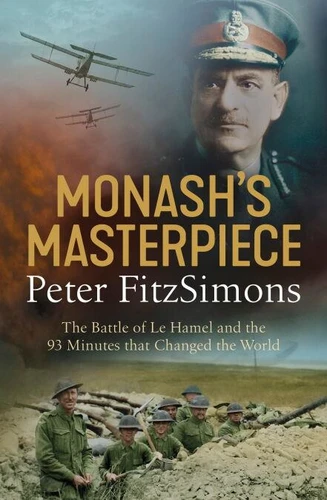Monash's Masterpiece. The battle of Le Hamel and the 93 minutes that changed the world
Par :Formats :
Disponible dans votre compte client Decitre ou Furet du Nord dès validation de votre commande. Le format ePub protégé est :
- Compatible avec une lecture sur My Vivlio (smartphone, tablette, ordinateur)
- Compatible avec une lecture sur liseuses Vivlio
- Pour les liseuses autres que Vivlio, vous devez utiliser le logiciel Adobe Digital Edition. Non compatible avec la lecture sur les liseuses Kindle, Remarkable et Sony
- Non compatible avec un achat hors France métropolitaine
 , qui est-ce ?
, qui est-ce ?Notre partenaire de plateforme de lecture numérique où vous retrouverez l'ensemble de vos ebooks gratuitement
Pour en savoir plus sur nos ebooks, consultez notre aide en ligne ici
- Nombre de pages448
- FormatePub
- ISBN978-1-4721-2901-7
- EAN9781472129017
- Date de parution06/06/2018
- Protection num.Adobe DRM
- Infos supplémentairesepub
- ÉditeurConstable
Résumé
The Battle of Le Hamel on 4 July 1918 was an Allied triumph, and strategically very important in the closing stages of WW1. A largely Australian force commanded by the brilliant John Monash, fought what has described as the first modern battle - where infantry, tanks, artillery and planes operated together, as a coordinated force. Monash planned every detail meticulously - with nothing left to chance: integrated use of planes, wireless (and even carrier pigeons!)was the basis, and it went on from there, down to the details.
Infantry, artillery, tanks and planes worked together of the battlefront, with relatively few losses. In the words of Monash: 'A perfect modern battle plan is like nothing so much as a score for an orchestral composition, where the various arms and units are the instruments, and the tasks they perform are their respective musical phrases.'
Infantry, artillery, tanks and planes worked together of the battlefront, with relatively few losses. In the words of Monash: 'A perfect modern battle plan is like nothing so much as a score for an orchestral composition, where the various arms and units are the instruments, and the tasks they perform are their respective musical phrases.'
The Battle of Le Hamel on 4 July 1918 was an Allied triumph, and strategically very important in the closing stages of WW1. A largely Australian force commanded by the brilliant John Monash, fought what has described as the first modern battle - where infantry, tanks, artillery and planes operated together, as a coordinated force. Monash planned every detail meticulously - with nothing left to chance: integrated use of planes, wireless (and even carrier pigeons!)was the basis, and it went on from there, down to the details.
Infantry, artillery, tanks and planes worked together of the battlefront, with relatively few losses. In the words of Monash: 'A perfect modern battle plan is like nothing so much as a score for an orchestral composition, where the various arms and units are the instruments, and the tasks they perform are their respective musical phrases.'
Infantry, artillery, tanks and planes worked together of the battlefront, with relatively few losses. In the words of Monash: 'A perfect modern battle plan is like nothing so much as a score for an orchestral composition, where the various arms and units are the instruments, and the tasks they perform are their respective musical phrases.'

















